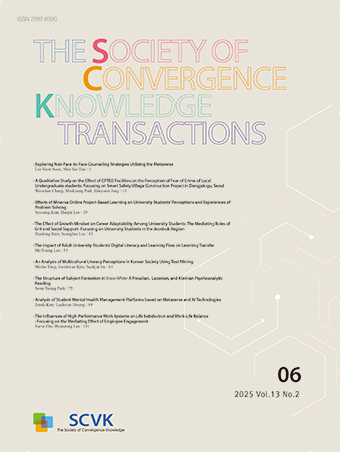Research Article
Abstract
References
Information
본 연구는 기존 국내에서의 리스크 정량분석의 한계점을 보완하기 위해 부분최소제곱 기반 구조방정식(PLS-SEM) 방법론을 활용하여 해외건설사업 리스크 요인들의 구조 및 영향관계를 분석하였다. 분석을 위하여 21개의 리스크요인들로 구성된 해외건설사업 공사비 RBS(risk breakdown structure)와 해외건설사업 실무자 경험기반의 리스크 평가사례 93건을 표본으로 활용하였으며, 분석을 통해 얻은 결론은 다음과 같다. 첫째, 구축된 측정모델과 구조모델의 유의성 평가결과 7가지의 평가 기준에서 모두 통계적으로 유의미한 것으로 나타났다. 이는 구축된 측정변수와 잠재변수, 잠재변수 간의 구조 관계가 타당하다는 점을 의미한다. 둘째, 구조모델에 대한 분석 결과, 잠재변수의 설명력이 가장 높은 항목은 ‘정치/정책(Political)’, ‘사회/문화(Culture)’, ‘법규/제도(Legal)’ 항목으로부터 영향을 받은 ‘사업수행여건(Market)’ 항목이 0.616의 R2 값으로 가장 설명력이 높았으며, 잠재변수 간 영향정도가 가장 높은 항목은 ‘지역/환경(Environment)’의 영향을 받았던 ‘사업수행여건(Market)’이 0.29의 f2 값으로 효과크기가 가장 컸음을 확인할 수 있었다. 때문에, 추후 국내건설기업들의 해외건설시장 진출 시, 단일적인 리스크 요인의 대응뿐만이 아닌 리스크 요인 간의 관계를 고려한 복합적인 리스크 대응방안의 구축이 필요할 것으로 사료된다.
This study analyzed the structure and link between risk factors in overseas construction projects by using the Partial Least Squares-based Structural Equation Modeling (PLS-SEM) to supplement the limitations of the existing quantitative risk analysis. For the analysis, 93 survey data of evaluation on the RBS (Risk Breakdown Structure) conducted by overseas construction project experts were used as variables and samples. The results are as follows. First, As a result of significance test of the constructed measurement model and structural model, all seven evaluation criteria were found to be statistically significant. This means that the structural relationship between latent and measured variables, latent and latent variables are appropriate. Second, the results of the analysis on the structural model, the item with the highest R2 score (0.616) is the market risk affected by political, culture, legal risk. The item with the highest f2 score (0.29) among latent variables is market risk affected by environment risk. When construction companies enter overseas, it is necessary to establish a complex risk countermeasure plan that considers relationship between risk factors.
- 강정화, "2020년 상반기 해외건설산업 동향", 한국수출입은행 해외경제연구소, 2020-2호, pp.1-17, 2020.
- 박선구, "2021년 건설경기 전망", 대한건설정책연구원, 제2020-09호, pp.1-42, 2020.
- 신동우, "아시아 해외건설시장 주요 동향 및 진출전략", 해외건설협회, pp.1-48, 2019.
- 강정화, "2019년 하반기 해외건설산업 동향", 한국수출입은행 해외경제연구소, 제2019-02호, pp.1-17, 2020.
- W. P. Utama, A. P. Chan, H. Zahoor, and R. Gao, "Review of Research Trend in International Construction Projects: A Bibliometric Analysis" Construction Economics and Building, Vol. 16, No. 2, pp. 77-82, 2016.https://doi.org/10.5130/AJCEB.v16i2.4866
- 유위성, 김우영, 이영환, "국내 건설기업의 해외 사업 리스크관리 역량", 한국건설산업연구원, pp.3-29, 2014.
- S. Laryea, and W. Hughes, "How Contractors Price Risk in Bid: Theory and Practice", Construction Management and Economics, Vol. 26, No. 9, pp. 911-924, 2008.https://doi.org/10.1080/01446190802317718
- 안병호, 김진언, 김예상, "건설사업 참여주체 별 해외건설공사 국가리스크 핵심요인 도출 및 비교분석", 한국건설관리학회논문집, 제14권 제2호, pp.150-153, 2013.https://doi.org/10.6106/KJCEM.2013.14.2.150
- W. S. Jang, J. K. Lee, J. Lee, and S. H. Han, "Native Bayesian Classifier for Selecting Good/Bad Projects during the Early Stage of International Construction Bidding Decisions", Mathematical Problems in Engineering, Vol. 2015, No. 10, pp. 1-12, 2015.https://doi.org/10.1155/2015/830781
- 황건욱, 박찬영, 장우식, 한승헌, 강신영, "해외 건설 다수 프로젝트 관리를 위한 허용리스크 도출 -중소 ‧ 중견 건설기업 관점에서", 한국건설관리학회 논문집, 제17권 제3호, pp.90-97, 2016.https://doi.org/10.6106/KJCEM.2016.17.3.090
- 송영한, 이정석, 김정학, 김재준, "아시아지역 투자개발형 사업의 리스크 인자 중요도 분석", 대한건축학회논문집, 제23권 제6호, pp.145-152, 2007.
- 이광표, 유위성, "국내 건설기업의 해외 프로젝트관리 역량 진단", 한국건설산업연구원, pp.1-33, 2018.
- 김성일, 이형찬, "구조방정식모형을 이용한 공공공사 클레임 발생 가능성 분석", 국토연구원, 국토연구 제4권, pp.53-68, 2004.
- D. Y. Kim, S. H. Han, H. Kim, and H. Park, "Structuring the Prediction Model of Project Perfomance for International Construction Projects: A Comparative Analysis", Expert Systems with Applications, Vol. 36, No. 2, pp. 1961-1971, 2009.https://doi.org/10.1016/j.eswa.2007.12.048
- 이용욱, 이상구, 장우식, 한승헌, "구조방정식을 활용한 해외건설 프로젝트 시공성 평가 모델", 대한토목학회논문집, 제35권 제4호, pp.941-951, 2015.https://doi.org/10.12652/Ksce.2015.35.4.0941
- 이창근, 장우식, 나승범, 이경수, "지역 간 리스크 특성에 따른 적정 확률분포를 활용한 해외건설공사 비용의 변동성 예측 방안에 관한 연구", 융복합지식학회논문지, 제8권 제3호, pp.133-142, 2020.
- C. M. Ringle, M. Sarstedt, and D. W. Straub, "Editor's Comments: A Critical Look at the Use of PLS-SEM in MIS Quarterly", MIS Quarterly, Vol. 36, No. 1, pp. 3-22, 2012.https://doi.org/10.2307/41410402
- J. F. Hair, M. Sarstedt, L. Hopkins, and V. G. Kuppelwieser, "Partial Least Squares Structural Equation Modeling (PLS-SEM)-An Emerging Tool in Business Research", European Business Review, Vol. 26, No. 2, pp. 106-121, 2014.https://doi.org/10.1108/EBR-10-2013-0128
- J. F. Hair, M. Sarstedt, C. M. Ringle, and J. M. Mena, "An Assessment of the Use of Partial Least Squares Structural Equation Modeling in Marketing Research", Journal of the Academy of Marketing Science, Vol. 40, No. 3, pp. 414-433, 2011.https://doi.org/10.1007/s11747-011-0261-6
- N. Bontis, and A. Serenko, "Longitudinal Knowledge Strategising in a Long-Term Healthcare Organisation", International Journal of Technology Management, Vol. 47, No. 1, pp. 250-271, 2009.https://doi.org/10.1504/IJTM.2009.024125
- W. W. Chin, "How to Write Up and Report PLS Analysis", Springer, pp. 655-690, 2010.https://doi.org/10.1007/978-3-540-32827-8_29
- C. Fornell, and J. Cha, Advanced Methods of Marketing Research, (Cambridge, Mass: Blackwell Business), pp. 52-87, 1994
- Publisher :The Society of Convergence Knowledge
- Publisher(Ko) :융복합지식학회
- Journal Title :The Society of Convergence Knowledge Transactions
- Journal Title(Ko) :융복합지식학회논문지
- Volume : 9
- No :3
- Pages :89-103
- DOI :https://doi.org/10.22716/sckt.2021.9.3.032




 The Society of Convergence Knowledge Transactions
The Society of Convergence Knowledge Transactions







